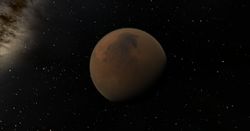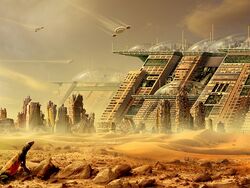Mars
Star System: Sol
Development level: Medium-High; Pockets of Open Metropolises, Biodomes, Large Space Stations, Cramped Slums, Developed Infrastructure
Capitals: Olympia (planetside); New/Nova Concordia Station (orbital)
Terrestrial Population (est.): 4,592,943,380
Spacer Population (est.): 1,372,248
Mars is the fourth planet out from Sol. It orbits Sol at approximately 1.52 AU. A Martian day is only slightly longer than a standard day at 25 standard hours, but the Martian year is 687 standard days long. It is the outermost terrestrial planet in the Sol system. It is known as the Red Planet because the iron-rich dust that covers most of the planet’s surface gives it a reddish tinge that was visible to the naked eyes of astronomers on Earth in ancient times. Mars has a relatively thin atmosphere.
Mars was one of the first bodies colonized by humanity. It's population swelled in the early days of the Second Space Race as prospectors sought to claim their fortune mining the planet to satisfy Earth's ever-growing need for raw materials. It's population reached a peak in the 2200's when one of humanity's first global terraforming efforts backfired, killing millions as decades of steady environmental changes were undone in seconds. Mars has slowly been recovering since then, but has never quite been able to shake the reputation of being a 'massive failed project'.
Suffering extensive damage as a result of the Second Sol Alliance Civil War, Mars was the fortunate recipient of human aid. Small scale terraforming projects allowed for limited zones of habitability within the largest craters. These small pockets saw a boom in development, as people migrated from centuries old biodomes into newly constructed open cities. As with Luna, Mars was flooded with Earth-refugees, who largely took over the old bio domes. In spite of a civil construction surge, housing is a constant problem, as the open cities struggle to support any additional development and those living in the biodomes are subject to cramped spaces and inadequate basic services.
Overall, Mars, like Earth, has made a dramatic recovery, prompting some to call for full, planetary terraforming efforts to turn the planet into a 'New Earth'. However, along with it's housing problems, Mars is riddled with ruins as a result of the Alliance Civil War, which has rendered some areas uninhabitable or even radioactive. There are ongoing efforts to undo this damage by Alliance, local government and private interests, but most estimates claim that Reclamation efforts will take 30 years, at least. It is also estimated that at least 500 million Martians are living in various ruins in deplorable conditions far worse than those in the most overcrowded biodome.
Mars' economy is developed and mixed, with it's largest industries being orbital construction, mining, salvaging and a small but rapidly growing hydroponics industry. Mars also enjoys being the center of Sol trade, with over 90% of Sol's trade at some point passing through the planet or one of it's stations, due in no small part to the Memorial Warp Gate near the planet.
The planetary capital of Mars is Olympia, located within the Galle Crater Terraformed Zone, but a majority of senior administration facilities and personnel reside in orbit on New Concordia station along with the highest echelons of Sol Alliance leadership and bureaucracy.

